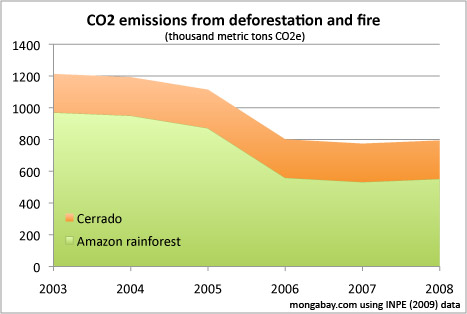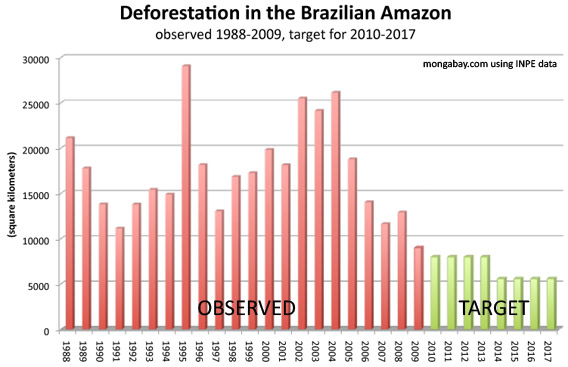|
|
A criação de gado é responsável pela metade das emissões brasileiras dos gases de efeito estufa de acordo com um novo estudo conduzido por cientistas do Instituto Nacional de Pesquisas Espaciais do Brasil (INPE).
A pesquisa descobriu que as emissões da criação de gado na Amazônia e no cerrado, uma vegetação típica rasteira ao sul da Floresta Amazônica, gerou 813 milhões a 1.09 bilhões de toneladas de emissões de dióxido de carbono entre 2003 e 2008. A Amazônia foi responsável por 499 a 775 milhões de toneladas de emissões de CO2, enquanto o cerrado foi responsável por 229-231 milhões de toneladas.
As emissões da criação de gado em outras partes do país somaram 84-87 milhões de toneladas no período.

|
O estudo, que é baseado no uso do sistema brasileiro com tecnologia de ponta no monitoramento de terras descobriu que 75 por cento da floresta desmatada durante o período acabou sendo usada para pastoreio de gado, e 56 por cento do desmatamento do cerrado resultou em terras para pastagem.
O estudo estima que cada quilograma de bife brasileiro está associado á 300 quilogramas (660 libras) de emissões de CO2.
“Descobrimos que o custo das emissões de carbono por unidade de saída excede o custo real do produto como um todo na venda,” disse Roberto Smeraldi da Amigos da Terra – Amazônia Brasileira, um co-autor do estudo.
Os autores, liderados por Carlos Nobre do INPE, disseram que o estudo mostra que o Brasil precisa se concentrar em maneiras de reduzir o impacto ambiental da criação de gado a fim de cortar as emissões de gases de efeito estufa. Eles sugerem que poderia haver reformas políticas que aumentassem a vigilância da lei e melhorassem as praticas de manejo da terra diminuindo assim o desflorestamento e as emissões associadas á ele. Os pagamentos pela restauração e conservação da floresta seria algo que poderia incentivar os criadores de gado a adotar abordagens mais ecologicamente responsáveis. Além disso, poderia haver uma certificação dos produtos agrícolas da Amazônia que permitisse o rastreamento da cadeia de fornecimento de volta aos rancheiros e criadores de gado para forçar um desempenho ambiental mais responsável entre os produtores.
O Brasil se ofereceu para reduzir as emissões em quase 40 por cento do níveis projetados (14 a 19 por cento abaixo dos níveis de 2005) até 2020. A maior parte da redução viria de uma redução de 70 por cento nas taxas do desflorestamento.
 Os níveis propostos pelo Brasil na redução do desflorestamento: |
Artigos Relacionados
O Brasil poderia acabar com o desflorestamento dentro de uma década

(12/03/2009) Funds generated under a U.S. cap-and-trade or a broader U.N.-supported scheme to reduce greenhouse gas emissions from deforestation and degradation (“REDD”) could play a critical role in bringing deforestation in the Brazilian Amazon to a halt, reports a team writing in the journal Science. But the window of opportunity is short — Brazil has a two to three year window to take actions that would end Amazon deforestation within a decade.

(11/19/2009) Under the Kyoto Protocol the nation that produces carbon emission takes responsibility for them, but what about when the country is producing carbon-intensive goods for consumer demand beyond its borders? For example while China is now the world’s highest carbon emitter, 50 percent of its growth over the last year was due to producing goods for wealthy countries like the EU and the United States which have, in a sense, outsourced their manufacturing emissions to China. A new study in Environmental Research Letters presents a possible model for making certain that both producer and consumer share responsibility for emissions in an area so far neglected by studies of this kind: deforestation and land-use change.
Concerns over deforestation may drive new approach to cattle ranching in the Amazon

(09/08/2009) While you’re browsing the mall for running shoes, the Amazon rainforest is probably the farthest thing from your mind. Perhaps it shouldn’t be. The globalization of commodity supply chains has created links between consumer products and distant ecosystems like the Amazon. Shoes sold in downtown Manhattan may have been assembled in Vietnam using leather supplied from a Brazilian processor that subcontracted to a rancher in the Amazon. But while demand for these products is currently driving environmental degradation, this connection may also hold the key to slowing the destruction of Earth’s largest rainforest.
Brazilian beef giant announces moratorium on rainforest beef

(08/13/2009) Brazil’s second-largest beef exporter, Bertin, announced it would establish a moratorium on buying cattle from farms involved in Amazon deforestation, reports Greenpeace. The move comes after the World Bank’s International Finance Corporation (IFC) withdrew a $90 million loan to Bertin following revelations in a Greenpeace report that the company was buying beef produced on illegally deforested lands. The report, which linked some of the world’s most prominent brands to rainforest destruction in the Amazon, had an immediate impact, triggering a cascade of events.
Timberland announces policy to avoid using leather produced by Amazon destruction

(07/29/2009) Timberland, a maker of hiking boots and other footwear, today announced it would demand a moratorium on leather produced from newly deforested areas in the Amazon. The move is a direct response to pressure from Greenpeace, which last month released Slaughtering the Amazon, a report that linked some of the world’s most prominent brands to illegal clearing of the Amazon rainforest. Timberland says it will require its leather suppliers to commit to the moratorium on newly deforested areas in the Amazon. Greenpeace says the policy “makes Timberland the industry leader in environmentally and socially responsible Brazilian leather procurement.”
Nike implements policy to avoid leather produced via Amazon deforestation
(07/22/2009) Nike is working with Greenpeace to ensure its products don’t contribute to destruction of the Amazon rainforest, according to statements from the shoe giant and the environmental activist group. The partnership comes after Greenpeace report accused Nike of using leather derived from cattle raised on illegal deforested Amazon land. The report, “Slaughtering the Amazon”, also linked other shoemakers to rainforest destruction, including Adidas, Reebok and Timberland.
Brazil’s development bank to require beef-tracking system to avoid illegal Amazon deforestation
(07/01/2009) Responding to allegations that major Brazilian cattle producers are responsible for illegal forest clearing in the Amazon, Brazil’s development bank BNDES will soon require processors to trace the origin of beef back to the ranch where it was produced in order to qualify for loans, reports Brazil’s Agencia Estado. The traceability program aims to ensure that cattle products do not come from illegally deforested land.
Nike, Unilever, Burger King, IKEA may unwittingly contribute to Amazon destruction, says Greenpeace

(06/01/2009) Major international companies are unwittingly driving the deforestation of the Amazon rainforest through their purchases of leather, beef and other products supplied from the Brazil cattle industry, alleges a new report from Greenpeace. The report, Slaughtering the Amazon, is based on a three-year undercover investigation of the Brazilian cattle industry, which accounts for 80 percent of Amazon deforestation and roughly 14 percent of the world’s annual forest loss. Greenpeace found that Brazilian beef companies are important suppliers of raw materials used by leading global brands, including Adidas/Reebok, Nike, Carrefour, Eurostar, Unilever, Johnson & Johnson, Toyota, Honda, Gucci, Louis Vuitton, Prada, IKEA, Kraft, Tesco and Wal-Mart, among others.
O consumo de carne acelera a destruição da floresta tropical

(02/16/2009) Nearly 80 percent of deforestation in the Brazilian Amazon results from cattle ranching, according to a new report by Greenpeace. The finding confirms what Amazon researchers have long known – that Brazil’s rise to become the world’s largest exporter of beef has come at the expense of Earth’s biggest rainforest. More than 38,600 square miles has been cleared for pasture since 1996, bringing the total area occupied by cattle ranches in the Brazilian Amazon to 214,000 square miles, an area larger than France. The legal Amazon, an region consisting of rainforests and a biologically-rich grassland known as cerrado, is now home to more than 80 million head of cattle. For comparison, the entire U.S. herd was 96 million in 2008.
COMPARTILHE ESTE ARTIGO:

|
function fbs_click() 
|
|||||||||